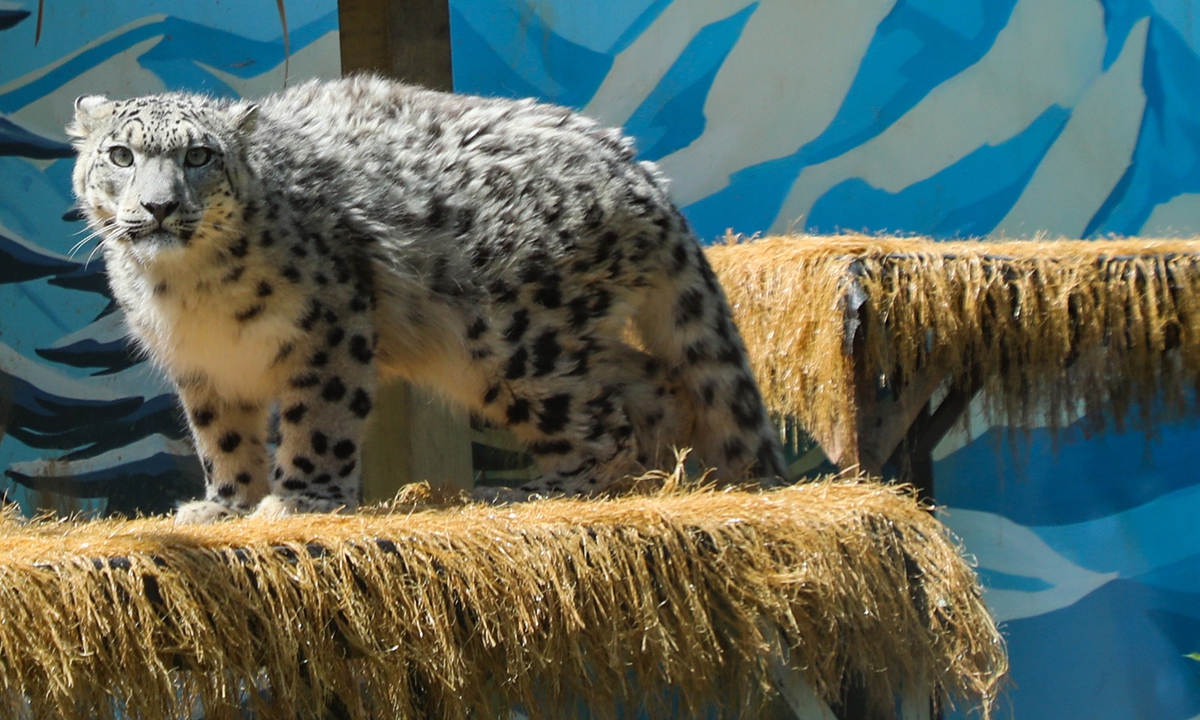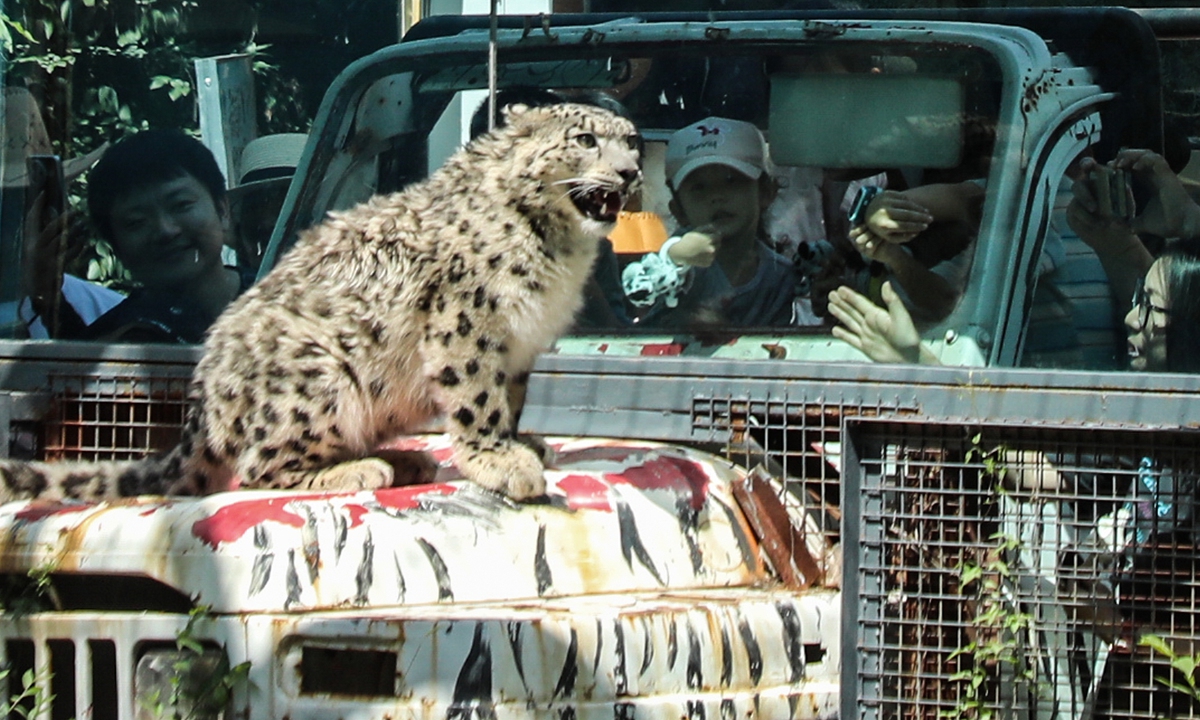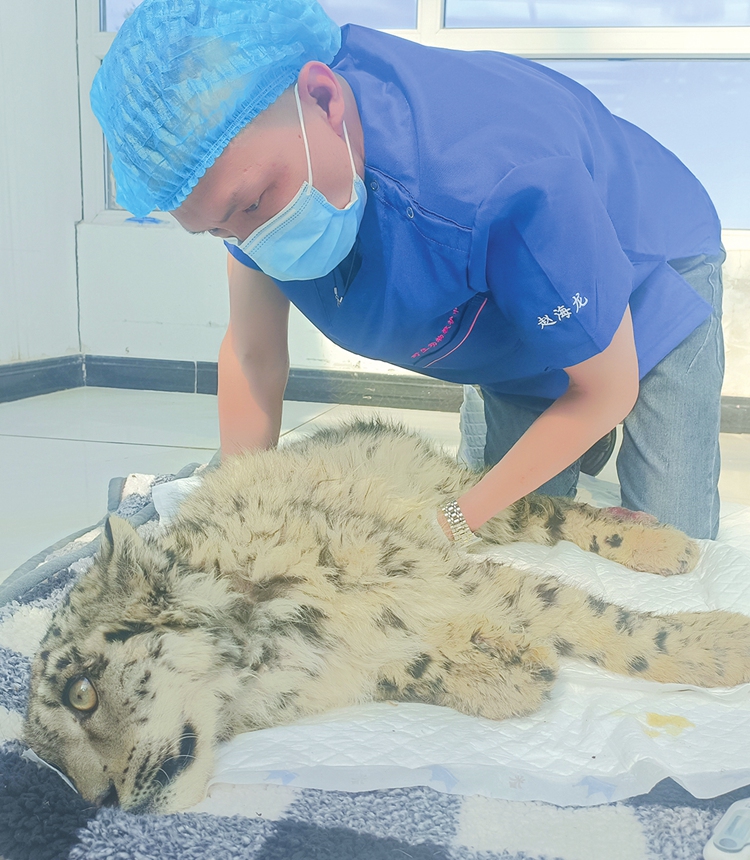
The snow leopard Ling Xiaozhe Photos: VCG

The snow leopard Ling Xiaozhe Photos: VCG
On Saturday, the weather in Xining, Northwest China’s Qinghai Province, was clear and bright. Outside the glass walls of the snow leopard enclosure at the Xining Wildlife Park, camera lenses focused on a young snow leopard called “Ling Xiaozhe” as it occasionally gnawed on the wire mesh beside it before turning to look back at the eager “fans” waiting on the other side.
Ling Xiaozhe’s smoky-gray fur is dotted with rings of black rosettes.This young snow leopard is currently the “superstar” of the wildlife park, captivating not only park visitors but also tens of thousands of online followers.
Through regular rehabilitation video diaries released by the park staff, the public has witnessed how this cub, once little more than “skin and bones,” overcame critical danger. Thanks to the joint efforts of the park’s veterinarians and animal medical experts – providing warmth, oxygen therapy, antibiotics and more – Ling Xiaozhe survived a series of life-threatening challenges, ultimately achieving a true miracle of life.
The miracle would not have been possible without the wildlife rescue team at the park, led by veterinarian Zhao Hailong.
Ling Xiaozhe, Ling Xiaomang, Ling Zhe, Ling Shuang, Ling Xia… Since 2017, every snow leopard rescued by the park bears the character “Ling” in its name. Over the past eight years, 12 snow leopards have been treated. “The character ‘Ling’ evokes ice and snow, perfectly matching the snow leopard’s temperament. It also means to rise or soar; we hope every rescued snow leopard can overcome adversity,” Zhao told the Global Times.
A race against death
Now, Ling Xiaozhe can freely climb and play, interacting with visitors inside and outside his enclosure. The zoo provides ample space for muscle development and simulates wild environments. Yet, as he watched its lively antics each day, Zhao still recalled the heartache of seeing the wild animal for the first time.
On March 4 of this year, rangers at Sanjiangyuan National Park discovered a dying snow leopard cub. “From the field video, it was clear the snow leopard needed to be rushed to the hospital immediately. If we waited to reach our park, it would have been too late,” Zhao recalled. Veterinarians instructed the convoy to keep the car warm, provide glucose and water, and update them constantly. That night, through heavy snow, two staff of the administration of the Sanjiangyuan National Park drove over 1,000 kilometers to Xining.
Zhao saw Ling Xiaozhe by the afternoon of March 5. Despite being fed milk en route, it was dangerously thin and weighed less than 10 kilograms. Vets speculated the six-month-old cub was injured learning to hunt with his mother, falling from a height and sustaining nerve damage that left it paralyzed.
Though on the verge of death, the tenacious cub showed a will to live, eating fresh rabbit meat. After a week of intensive care, its condition stabilized – it progressed from lying down to propping itself up. Staff placed meat half a meter away, and its desire for food drove it to crawl to reach it.
Standing was still difficult. To restore its atrophied muscles, Zhao massaged and stretched it daily. More than 20 days later, Ling Xiaozhe attempted to drag its weak hind limbs and managed to stand and walk.
“In recent years, our medical equipment and facilities have steadily improved. Now, rescued snow leopards and other wildlife no longer need to be transferred elsewhere for tests, and we can monitor their health more precisely,” Zhao said. The center’s laboratory, operating room, and other facilities all operate independently, with comprehensive medical equipment.
Beyond veterinary care, Ling Xiaozhe, during its recovery, was welcomed by its keeper. The teamwork between treatment and husbandry is now well established.
Zhao carefully explained to each keeper the physiology and personality of every snow leopard; if any issues arise, veterinarians intervene promptly.
Love brings new life
The park’s veterinarians illustrated Ling Xiaozhe’s recovery as a comic, inviting online supporters to join its unique journey. Previously, former deputy director Qi Xinzhang wrote “Princess Ao Xue’s Diary” in the first person for the park’s snow leopard Ao Xue, based on keeper records.
Beneath videos of Ling Xiaozhe, many viewers repeated the same line: “Turns out, love really does bring flesh to bone.” Ling Xiaozhe’s story is the living embodiment of that thought.
As Zhao and his colleagues give new hope to these “spirits of the mountains” with love, the snow leopards, in turn, warm the hearts of their caregivers. Zhao remembers an adult snow leopard, Ling Zhe, who was released after recovery with a satellite collar. As Ling Zhe stepped out of the cage and walked toward the wild, it turned head back to Zhao for a moment, as if to say goodbye. He has cherished that look for four years.
Half a year of post-release, monitoring showed Ling Zhe traveled around 790 kilometers, covering 1,700 square kilometers, before settling in the Qilian Mountains, where it now thrives.
Snow leopards are the “barometer” of the plateau ecosystem’s health, Li Sheng, a researcher at Peking University’s School of Life Sciences, told the Global Times. China is the main habitat for snow leopards, covering 60 percent of the world’s snow leopard range. Qupeng, a local herder in Qinghai and passionate photographer, documented the plateau’s wildlife, sharing their beauty to raise awareness. He said that he has photographed diverse wildlife and hopes to arouse people’s awareness to protect them and their home.
“Our ‘home’ is getting better, and I hope more people will notice these wild animals in need and use their power to ensure they are remembered for longer,” Zhao noted.

Zhao Hailong treats a snow leopard Photo: Courtesy of Zhao Hailong